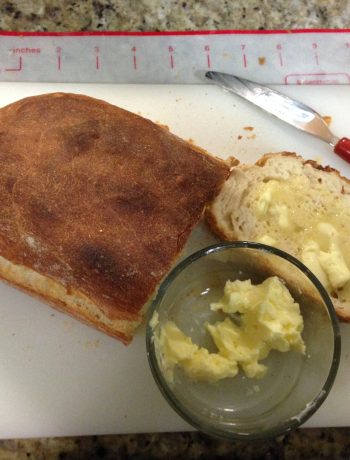It’s been more than one day since I made last week’s loaf, but this is the first time after that day, so, this is the second day. Sort of. I’m following Kitchn’s Basic White Sandwich Bread recipe today. First up, the temperature of the water. They give an explanation, too hot to handle, blah blah – I need a lot more detail, I’m afraid. So I located a source that said between 95-115 F. I heated the water in the microwave for 20 seconds, and got to 95F, then I poured it in my big metal bowl and – oh yeah, it lost about 5 degrees to the cool metal. I left it in there to warm up the metal, and did another glass.
See where this is going? On the third cup of water, it got to 104, and only lost a couple degrees in the bowl since the bowl was now warming up a little. (Hmm maybe I am OCD after all?)
Next up, 2 teaspoons of yeast. The packet says it’s about 2 1/4 teaspoons, so I measured it over a little bowl. I got 2 teaspoons from the packet. OK, entire packet goes in (Red Star Active). Then a mixture of the milk, sugar and salt (1 Tablespoon seems a lot) with melted butter goes into the yeast with a cup of the flour – I used bread flour although it calls for all-purpose. After that, add more flour and knead.

The first rise – when they say “doubled” of course I wonder, am I supposed to have some measure like width or height? – was about 1 hour (while I worked on making mascarpone, and hoped multi-tasking would not end up being a problem). Now I’m following a tutorial for forming the loaf. The first photo is after the first rise.

Then it is divided into 2 loaves.

And then formed into a loaf – here’s the tutorial at Kitchn.

I have done very little reading on the science – things seem to make more sense to me if I understand why I’m doing something, and it sticks in my head a little better. Also I only have 1 clay loaf pan, and I can’t find the other ceramic loaf pan I was sure I had, so I’m using a metal pan for the second loaf. It’ll be like a test, right?

The second rise. To cover or not to cover? It doesn’t say. I stuck them in the microwave. I’m looking at these photos and thinking about what the tutorial said about the what it should look like:
get the surface of the loaf as taut as possible.
I’m thinking I might not have achieved that goal on these 2 loaves. But I did remember to set out some cream to make sweet cream butter, so life is good. Except – hmmm – the second rise isn’t happening. I’m looking for some wisdom on this and learning if you let it rise too much the first time, the second rise will take longer. There’s some science in there that I need to figure out – it seems you need to be more aware of the volume and less of the time for the first (and second?) rise. One person writes that she uses the 5-minutes-a-day method of letting it rise in a large translucent plastic bucket, and she puts a rubber band around the container to indicate the original height so she can tell when it has doubled. Got it. That kind of stuff makes sense to me. The King Arthur Flour site postulates that you might have used the wrong size loaf pan. If it doesn’t indicate pan size (and this recipe doesn’t) go for the smaller pan if it’s 3 cups of flour. The smaller size is 8 1/2 X 4 1/2, vs 9 X 5. I can see from my photo that the clay pan is smaller than the pan on the left. I actually have 2 or 3 of the smaller metal loaf pans I could have used (and will for the next trial).

You can see the darker pan is quite a bit smaller, actually! and measures 8 1/2 X 4 1/2 inside.

It’s even a little smaller than the clay pan.

The loaf on the left came out of the clay pan, and is slightly higher as a result of having less width. All is well with my world!

Loaf on left – clay pan. I actually followed some instructions I found somewhere – didn’t bookmark – to allow the loaves to cool completely before cutting, which does something-something and something else, and makes them last longer. It’s something like, the heat continues to cook the inside, and… honestly I can’t remember. Man, was it ever hard to smell and know I had to wait! While I waited, I whipped up some butter from cream.

It was just half a cup of cream, so slightly less butter. But yeah, even though the bread was now room temp, this butter made it all good. All is still right with my world.



No Comments